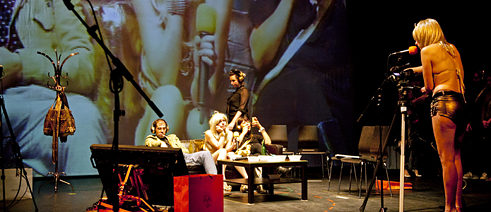Theatre and Participation I
Participation as interaction with the audience

Theatre takes place before an audience. It therefore presupposes participation. Even the traditional proscenium stage, which disciplines and blanks out its audience in the darkened auditorium, depends on their active understanding and experience. Since the 1990s, however, an interactive model has come more and more to establish itself in the theatre and re-defined the role and position of the audience: as mobile actor that actively co-shapes the reality of the performance.
For some time the bar in the mysterious place of Ruby Town has stood empty. “This is about participation, isn’t it”, says my companion, smiling, and goes behind the bar and pours us a vodka. Straightaway we are apprehended by the residents and convicted by a summary court martial for attempted theft. After a good twenty minutes’ imprisonment in a musty, subterranean dungeon, the boundary between theatre and reality begins to dissolve.
No one in the German theatre scene entangles the audience more radically in the reality of a theatre performance than does the Danish performance collective SIGNA. In Ruby Town, the military-guarded camp and setting of Die Erscheinungen der Martha Rubin (The Ruby Town Oracle), which was invited to the 2008 Berlin Theatre Meeting, the viewers must directly confront the interned residents. Those who would discover the secrets and stories of this community embark on their own in the search for clues, in close contact with the actors, who under no circumstances abandon their roles, for 250 hours. For this distinctive theatre experience SIGNA built 26 houses in a former engine shed on 2,184 square metres in Berlin-Tempelhof: the stage world of a totalitarian regime, sustained by means of theatre illusion, in which real time passes and thus the present dominates. The audience here become actors, artistically manipulated but responsible for themselves, in a social experiment that negotiates power, powerlessness, sexual exploitation and the subjective boundaries of the scope of action. Whether what happens in the fictional “as if” performance is located in or evaluated according to the ethical principles of the everyday world, and how far the participation goes, is up to each individual participant.
The audience as actor
The pre-conceived scope of action, which in every performance the participants realize differently, varies considerably in participative theatre forms. But what they all have in common is an approach by which the traditional hierarchy of exclusive communication from stage down to the audience, as is embodied in the architecture of the German municipal theatre, is dissolved by interaction. That for the theatre participation has become so important since the 1990s is directly linked to the critique of its elite structure of production. In historical retrospect of the twentieth century the American art historian Claire Bishop accounts for this “social turn” in art in terms of the political failure of the idea of equality: the collapse of the socialist states in 1989. Here she returns to the beginnings of participative art as the practice of the historical avant-garde and to its programme of translating art into life.The conditions under which participation has in fact an emancipatory effect and can influence social and political power relations are also discussed by the French philosopher Jacques Rancière and the theatre scholar Hans-Thies Lehmann. For theatre is a special form in the arts: through its proximity to religious ritual in antiquity and the Middle Ages it was already a kind of participative practice long before it became art in the bourgeois theatre epoch of the eighteenth and nineteenth centuries and discovered the audience as an object of aesthetic education. In contemporary theatre practice the politically engaged movement of the neo-avant-garde especially continues to have an effect: flexible, community-creating formats such as happenings and performances or interventions in public space. Whether the audience goes through the city to small venues in private flats, as in the format X-Wohnungen of the theatre-maker and director Matthias Lilienthal, comes together in play groups to play along with the true-to-life point’n’click adventures of the Hildesheim collective machina eX, or votes on the future of Europe, as in Interrobang’s Preenacting Europe – participative aesthetics aims at a mobile and active audience that decisively helps shape the reality of a performance.